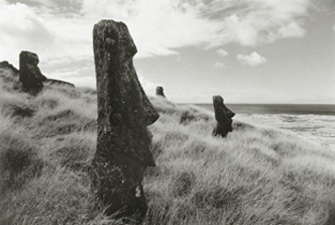Kenro Izu Sacred Places
Kenro Izu Sacred Places
Kenro Izu: Sacred Places showcases a magnifcent ensemble of more than 50 of Izu’s photographs of spiritual landmarks in Asia, the Pacifc Islands, Egypt, and Europe, many of which have never before been exhibited. Clark Worswick, curator of photography for the Peabody Essex Museum, has long been a supporter and advocate of Izu’s art. He says the Japanese-born photographer works in the tradition of both the great 19th century landscape photographers and early 20th century pictorialists. As such, his work is right at home at the Peabody Essex, which holds the largest collection of 19th century photographs of Asia. “With Izu you have a photographer who is working against the grain in contemporary photography in a classical form. I think he is one of the greatest photographers working in the world today,” says Worswick.
Among Izu’s most renowned images are those of the ancient Angkor temples in Cambodia. The photographs capture the stunningly beautiful Khmer architectural monuments and the natural landscape surrounding—and in some case destroying —them. These select photographs were first shown to the public in 1998 in a special exhibition at the Kiyosato Museum of Photographic Arts, Kenro Izu: Light over Ancient Angkor. Izu’s photography of Angkor also brought him close to the suffering of Cambodian children whose limbs had been shattered by land mines. He helped establish a free-care hospital for those children, and has supported it with proceeds from the sale of his photographs through an organization he set up called Friends without a Border.
Kenro Izu was born in Osaka in 1949 and attended the Nihon University College of Art before moving to New York City in the early 1970s. After discovering Francis Frith’s mammoth plate photographs of Egypt, he traveled there in 1979 to photograph the pyramids and other ancient monuments, and the Egyptian landscape. He later photographed holy sites in Syria, Jordan, England, Scotland, Mexico, and Easter Island. A practicing Buddhist, Izu has most recently focused his energies on Buddhist and Hindu sites in India, Cambodia, Burma, Vietnam, and Indonesia. Besides those of Angkor, Kenro Izu: Sacred Places will include sumptuous photographs of hallowed monuments in Borobodur, Indonesia; Agra and Varanasi in India; and Mandalay, Burma.
Many of these sites face destruction, either through neglect or overexposure to human contact. The importance of documenting the beauty of such sites was reinforced recently with the destruction of ancient Buddhist sculptures in Afghanistan. But Izu’s photography is not a staid documentation of endangered architecture. “The important thing is the spirituality of these monuments,” he once told an interviewer. “It’s not just a photograph of a building. The building has to be there to photograph but the atmosphere is what I’m interested in. The building is a representation of that spiritual side.”
Izu succeeds in capturing that spiritual essence of the places he photographs through his exacting approach to his craft, says Worswick. The camera he uses is enormous, producing 14 x 20 inch negatives. Izu meticulously pores over every image and takes out visual elements he believes are unnecessary. During a three-day period Izu prints his negatives into positive images on fine watercolor paper hand-coated with a platinum emulsion. The resulting palladium/ platinum prints “are among the most finely crafted prints ever made in the history of the photographic medium,” adds Worswick. All photographs are lent by The Lane Collection, courtesy of the Peabody Essex Museum.

Moai at Rano Raraku, Easter Island, 1989
Platinum palladium print on watercolor paper
